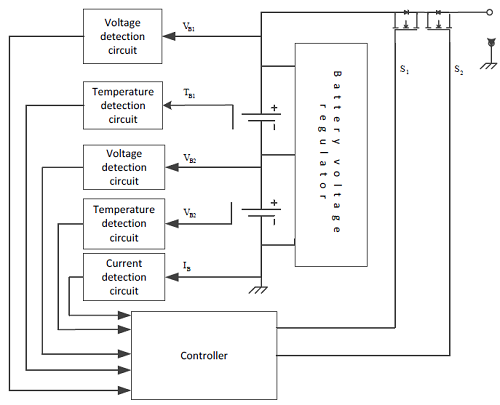Battery Management System for 24-V Battery-Powered Electric Wheelchair
DOI:
https://doi.org/10.46604/peti.2018.2927Keywords:
battery management system (BMS), digital signal processor, battery balance, battery protectionAbstract
This paper describes a simplified battery-management system using a digital signal processor for a 24-V battery-powered electric wheelchair to modulate and protect the battery from operating outside its safe operating area, such as over-temperature, under-temperature, over-voltage, under-voltage, over-current discharge, or over-current charging. Using the buck-boost circuit topology, we achieved and demonstrated both battery balance and protection in a prototype 12-V/40-Ah series-connected two-battery module. Simulation results show that the proposed battery management system is feasible for a 24-V battery-powered electric wheelchair application.
References
M. Wada and F. Kameda, “A joystick car drive system with seating in a wheelchair,” 2009 35th Annual Conference of IEEE Industrial Electronics, IEEE Press, November 2009, pp. 2163-2168.
Y. K. Kim, Y. H. Cho, N. C. Park, S. H. Kim, and H. S. Mok, “In-Wheel motor drive system using 2-phase PMSM,” 2009 IEEE 6th International Power Electronics and Motion Control Conference, Wuhan, May 2009, pp. 1875-1879.
P. Kishore, M. Ananth, S. Chidambaram, B. Vivekanandan, and N. A. Gounden, “Solar Based Hybrid Electric Powered Wheelchair,” 2013 Texas Instruments India Educators' Conference, IEEE Press, April 2013, pp. 18-24.
M. Wada, “Holonomic and omnidirectional wheelchairs with synchronized 4WD mechanism,” 2007 IEEE/RSJ International Conference on Intelligent Robots and Systems, IEEE Press, November 2007, pp. 1196-1202.
R. H. Putra, A. G. W. Rahman, E. S. Ningrum, and D. S. Purnomo, “Design and stress analysis on electric standing wheelchair,” 2017 International Electronics Symposium on Engineering Technology and Applications (IES-ETA), IEEE Press, September 2017, pp. 112-117.
K. Vitols and A. Podgornovs, “Concept of cost-effective power-assist wheelchair's electrical subsystem,” 2017 5th IEEE Workshop on Advances in Information, Electronic and Electrical Engineering (AIEEE), IEEE Press, November 2017, pp. 1-4.
K. K. Ayten, A. Dumlu, and A. Kaleli, “Real-time trajectory tracking control for electric-powered wheelchairs using model-based multivariable sliding mode control,” 2017 5th International Symposium on Electrical and Electronics Engineering (ISEEE), IEEE Press, October 2017, pp. 1-6.
M. J. Rana and M. A. Abido, “Energy management in DC microgrid with energy storage and model predictive controlled AC–DC converter,” IET Generation, Transmission & Distribution, vol. 11, no. 15, pp. 3694-3702, November 2017.
Q. Xu et al., “A Decentralized Dynamic Power Sharing Strategy for Hybrid Energy Storage System in Autonomous DC Microgrid,” in IEEE Transactions on Industrial Electronics, vol. 64, no. 7, pp. 5930-5941, July 2017.
D. Kumar, F. Zare, and A. Ghosh, “DC Microgrid Technology: System Architectures, AC Grid Interfaces, Grounding Schemes, Power Quality, Communication Networks, Applications, and Standardizations Aspects,” in IEEE Access, vol. 5, pp. 12230-12256, June 2017.
A. Merabet, K. Tawfique Ahmed, H. Ibrahim, R. Beguenane, and A. M. Y. M. Ghias, “Energy Management and Control System for Laboratory Scale Microgrid Based Wind-PV-Battery,” IEEE Transactions on Sustainable Energy, vol. 8, no. 1, pp. 145-154, Jan. 2017.
M. Farrokhabadi, S. König, C. A. Cañizares, K. Bhattacharya, and T. Leibfried, “Battery Energy Storage System Models for Microgrid Stability Analysis and Dynamic Simulation,” IEEE Transactions on Power Systems, vol. 33, no. 2, pp. 2301-2312, March 2018.
S. Sharma, S. Bhattacharjee, and A. Bhattacharya, “Grey wolf optimisation for optimal sizing of battery energy storage device to minimise operation cost of microgrid,” IET Generation, Transmission & Distribution, vol. 10, no. 3, pp. 625-637, March 2016.
B. Xie, Y. Liu, Y. Ji, and J. Wang, “Two-stage battery energy storage system (BESS) in AC microgrids with balanced state-of-charge and guaranteed small-signal stability,” Energies, vol. 11, no. 2, pp. 1-14, February 2018.
B. V. Mbuwir, F. Ruelens, F. Spiessens, and G. Deconinck, “Battery energy management in a microgrid using batch reinforcement learning,” Energies, vol. 10, no. 11, pp. 1846-1-1846-19, November 2017.
A. Hussain, V. H. Bui, and H. M. Kim, “Impact analysis of demand response intensity and energy storage size on operation of networked microgrids,” Energies, vol. 10, no. 7, pp. 882-1 - 882-19, June 2017.
A. Hussain, V. H. Bui, and H. M. Kim, “Fuzzy logic-based operation of battery energy storage systems (BESSs) for enhancing the resiliency of hybrid microgrids,” Energies, vol. 10, no. 3, pp. 271-1 - 271-19, February 2017.
A. Hussain, V. H. Bui, and H. M. Kim, “An energy-based control strategy for battery energy storage systems: a case study on microgrid applications,” Energies, vol. 10, no. 5, pp. 215-1-215-20, February 2017.
S. Y. Yu, H. J. Kim, J. H. Kim, and B. M. Han, “SoC-based output voltage control for BESS with a lithium-ion battery in a stand-alone DC microgrid,” Energies, vol. 9, no. 11, pp. 924-1 - 924-15, November 2016.
Y. S. Kim, C. S. Hwang, E. S. Kim, and C. Cho, “State of charged-based active power sharing method in a stad alone microgrid with high penetration level of renewable energy sources,” Energies, vol. 9, no. 7, pp. 480-1 - 480-13, June 2016.

Published
How to Cite
Issue
Section
License
Submission of a manuscript implies: that the work described has not been published before that it is not under consideration for publication elsewhere; that if and when the manuscript is accepted for publication. Authors can retain copyright of their article with no restrictions. Also, author can post the final, peer-reviewed manuscript version (postprint) to any repository or website.

Since Oct. 01, 2015, PETI will publish new articles with Creative Commons Attribution Non-Commercial License, under The Creative Commons Attribution Non-Commercial 4.0 International (CC BY-NC 4.0) License.
The Creative Commons Attribution Non-Commercial (CC-BY-NC) License permits use, distribution and reproduction in any medium, provided the original work is properly cited and is not used for commercial purposes







